I was very surprised to notice a widow spider perched in a web spun under the tiny ledge below my storage room door in Orlando, FL. I had never seen one in my life. My house is usually
completely bug-free and spider free, so I was surprised to see one of the few actual dangerous spiders in my home. At that time, I knew only of the Black Widow, but this
spider was clearly not black. However, it had the shape of a widow spider, and the infamous red (well, orange really) hourglass. I did some research, and found that there's
a few kinds of widow spiders out there, four different ones in Florida, including the Southern Black Widow, Northern Black Widow, Red Widow, and the Brown Widow. The venom of
all of these spiders is highly toxic and painful to humans (though not generally lethal). The research indicates that the Black Widow Spider bite is the worst. However, the
Brown Widow bite can be pretty bad, so I was careful. I picked it up with a pair of pliers and dropped it in
a plastic container. It completely shriveled up and stayed that way for many hours. I was certain that I had killed it with the pliers, and dumped it out onto some white paper
to take a photo.
Spider Identification Guide - with photos of USA dangerous species.
How to Treat a Spider Bite - proper medical procedures.
How To Get Rid of Spiders In and around the
home. How-to Guide.
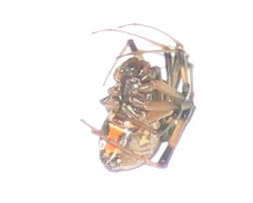
Here it is, all shriveled up in a ball. I thought that it was dead.
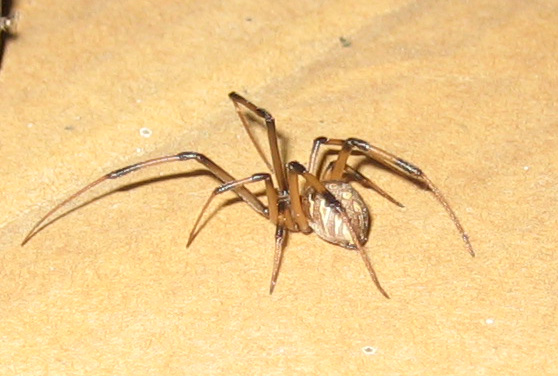
I thought to myself, "wouldn't it be funny if it somehow bit me from beyond the grave?" I placed the shriveled spider on its belly and began to try to spread its legs in order
to get a good pose for a photo, when WHAM, it sprung to life! I was absolutely shocked. It had remained in ball form for over four hours, after I had manhandled it with a
pair of pliers. I was certain that it was dead, but no, it was fully alive and in perfect condition!
I swept it back into the plastic container. At first I just threw a few bugs in there for it to eat. It was very interesting. It would approach a large ant, for instance,
and then turn around at the last second and start to throw webbing over the ant with its back two legs alone. Thus, it could catch and incapacitate bugs without any web. It
could catch them on the ground, by throwing out webbing with its hind feet. Very interesting.
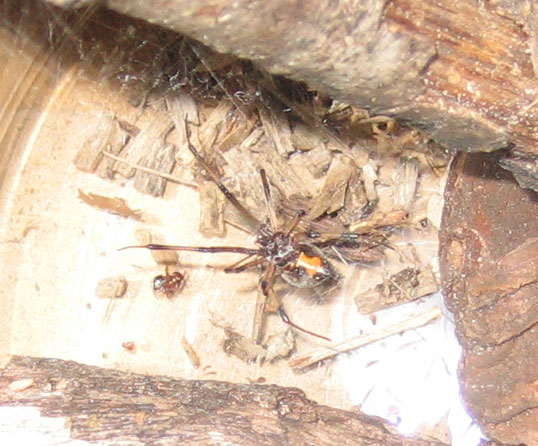
I finally added some debris into the container, and it promptly spun a web. The web is just a sloppy bunch of haphazard strands. However, it gets the job done. It's
always interesting to watch spiders move on the web. The web looks like a mess to me, but the spider navigates it just fine.
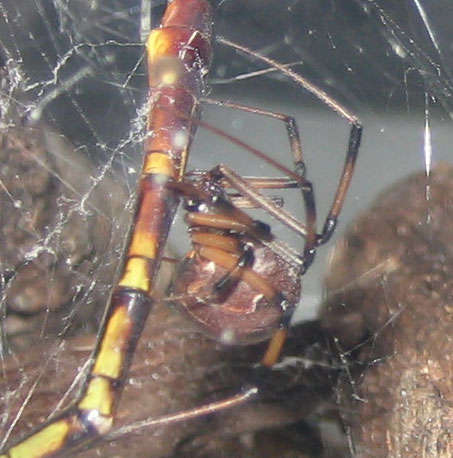
The spider was a real pig. I gave it way too much food, and it ate it all. I once gave it five large flies in one day. I also gave it large game, such as dragonflies. Here
we see it feeding on the tail of a huge dragonfly. Notice how fat the spider has become. It almost looks bloated.
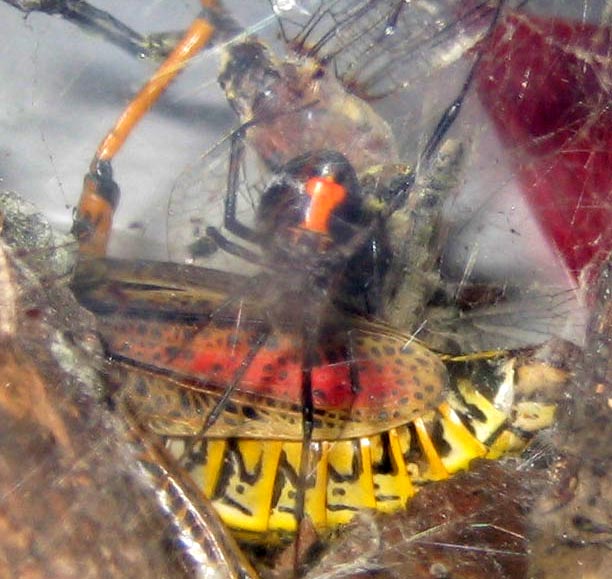
Over the course of time, the spider grew darker and darker. I could leave it with no food for weeks, and it was fine. I had trouble getting good photographs, because I had
to take the photos through the plastic, with no manual focus on my camera. Every time I opened the lid, the spider ran for cover and hid. Here we see the spider hanging
over the body of a luber grasshopper. Like I said, I gave it large meals.
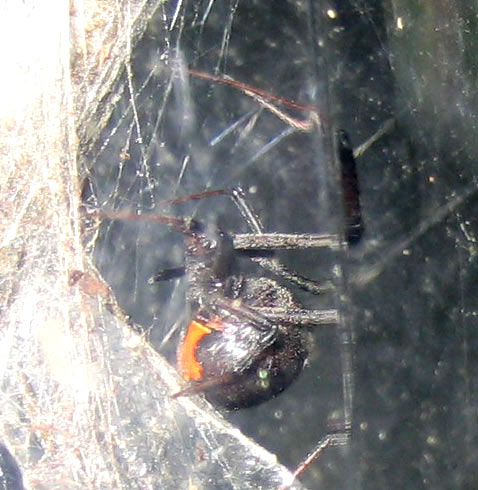
By now, the spider is even darker than in this photo, and almost fully black. It is not the slick, dark, complete black of a Black Widow, but it's fairly close.
I don't know anything about keeping spiders as pets, but it's pretty
easy to keep alive, and doesn't seem to require much. I'm not really into spiders, but there's something about the power the spider has, the ability to produce such a painful
bite, I suppose, that makes it appealing. In my job, I deal with wildlife all the time, so I know enough to be cautious around dangerous animals. The Brown Widow, however, is
easy, because it's so timid. That's why it curled into a ball for hours in the first place. Like most animals, it is misunderstood, and chooses flight before fight. This
spider would never actively seek out or attack a person or pet.
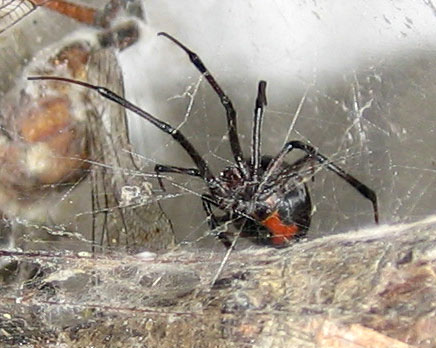
New photo. Even blacker. The hourglass remains orange, whereas the Black Widow has a red hourglass marking.
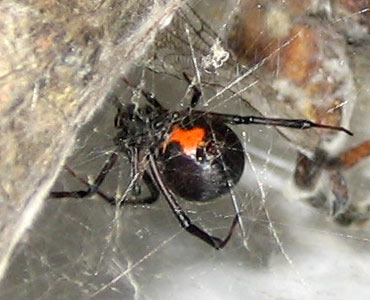
New photo. I wonder why the color has darkened like this. It looks pretty close to the Black Widow.
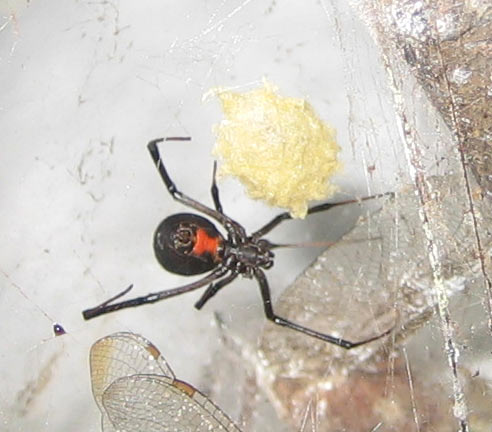
After two months in captivity, it spun this egg sac. The Brown Widow's egg sac is unique in that it features
bumps or spikes. The spider became noticeably thinner as a result.
Some of my other spider pages:
Hobo Spider Range - with USA map photograph
Brown Recluse Range - with USA map photograph
If you have a spider, insect, or wildlife website, consider
emailing me and maybe we can link sites.
Check out my friend's
Florida Honey Bee Removal page.
I've received probably over 100 emails about Brown Widow Spiders as a result of this web page. I'm posting the one below, with a few photos:
Hi, I'm from southern CA and happened on your site. I've become interested a bit in the brown widows and how their life cycle. I've been watching and photographing them in my yard over the last month or so.
This has led to several questions and theories which your site did a good job of providing information about. One issue that I've been wondering about the enormous range of coloring that I've seen. They get so black
that I'm not sure whether the blackest ones are brown or black widows. I've been looking at one large spider in particular trying to figure out if it is a black widow for sure or not. Its hour glass is split
significantly and it is significantly asymmetrical with one section almost non-existent. Based on what you said it sounds like it is a black widow. The fact that the hour glass is red and not orangey red might be
an indicator. Also something that you didn't mention was the yellow stripe on the head side of the hour glass that seems to always be on brown widows (although it is less prominent on some). Maybe the lack of that
is also a strong sign that the spider in question is a black widow. It is easily the largest spider in the my yard that I've been keeping track of and maybe that's another sign that it's a black widow.
I also had been wondering whether the brown widows darken with age or there are different color variations. I've been watching a fairly small black one and that, I thought, shot down my theory that they just darkened
with age. It seemed like if it was small it must be young. But I hadn't thought about the idea that they might shrink after they had laid their eggs. Maybe that's the reason this spider was small. I notice that I
haven's seen any males near the small black colored brown widow. One thought I've had is that the striking pattern that the brown widows have is some kind of sexual attractor and the pattern fades away after the spider has mated.
Another interesting thing to me is just how many of these things there are around here. I'm 59 and I've lived in Southern, CA most of my life and in that time I'd see a black widow every now and then, but I just don't
remember these brown widows but on the other hand I wasn't looking for them either. But I've seen many black widow egg cases in that time and before fairly recently I had never seen a brown widow egg case. Right now
they seem to be much more common than black widows. I've taken a walk around my neighborhood looking for these things and I could fine a brown widow on average about every ten feet or so along the sidewalk when the
side wall had some sore of wall next to it. Anyway, thanks for your site. Oh and congratulations on your courage on keeping these things in captivity. I thought about doing that but it seemed a little too dangerous.
Below are four of his photos:
I have friends in these areas:
Portland Animal Control |
Phoenix |
Houston |
Denver |
Boca Raton Exterminator |
Fort Lauderdale |
Palm Beach Exterminator |
Tampa Animal Control